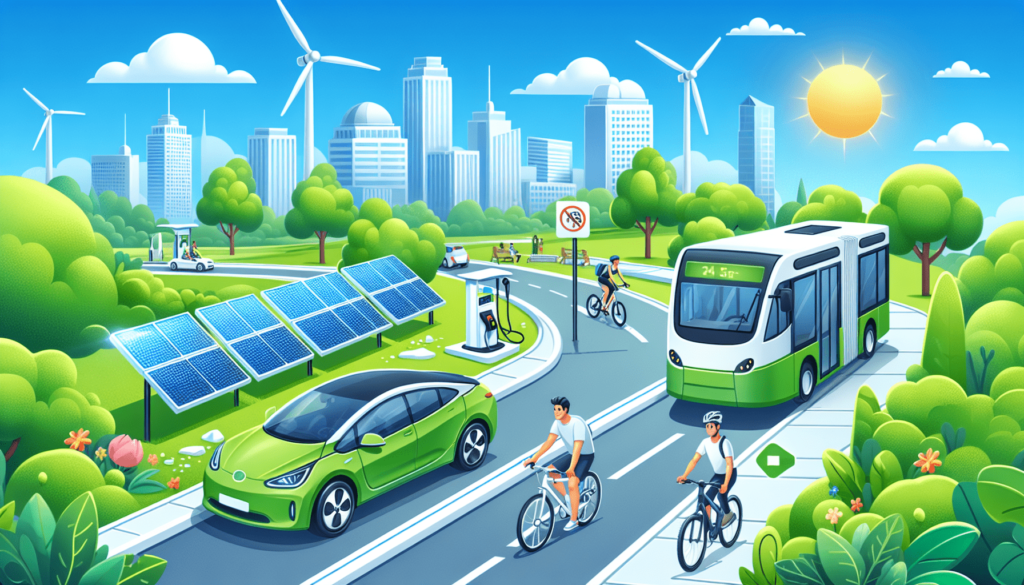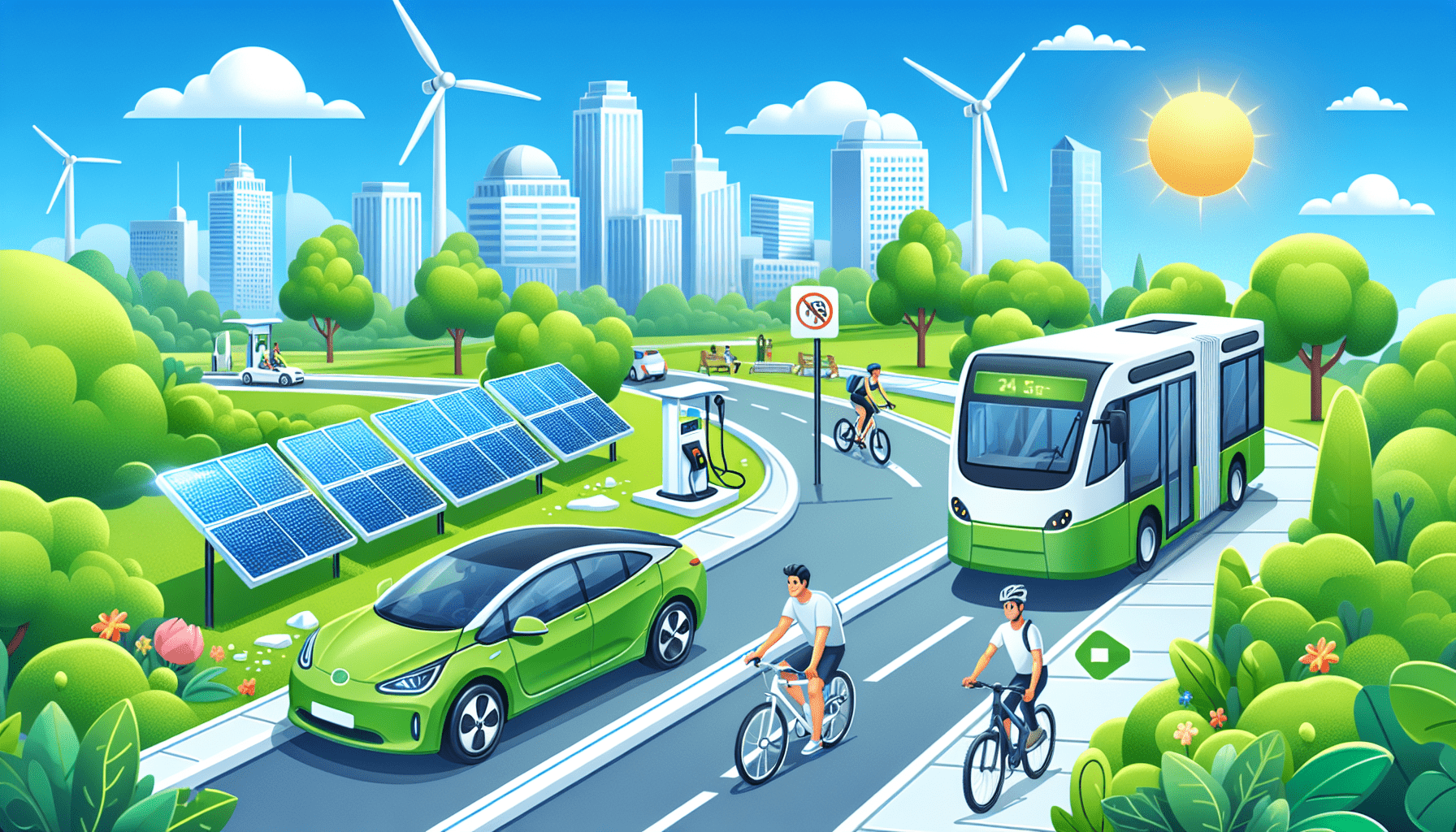Imagine a world where our daily transportation is not only efficient, but also environmentally friendly. A world where we can effortlessly commute to work, run errands, or go on road trips, all while reducing our carbon footprint. This is the vision of green transportation modes, which encompass a variety of eco-friendly options such as electric vehicles, bicycles, and public transportation. In this article, we will explore the numerous advantages that these green transportation modes offer, including reduced air pollution, improved health, and cost savings. So hop on board and discover the positive impact that green transportation can have on both our lives and the planet.
1. Reduced Carbon Emissions
Environmentally Friendly Option
Green transportation modes, such as walking, cycling, and using public transportation, are known for their significant contribution to reducing carbon emissions. By choosing these modes of transportation, you are actively participating in the fight against climate change and doing your part to create a more sustainable future. These options produce significantly fewer greenhouse gas emissions compared to traditional vehicles, making them a more environmentally friendly choice.
Contribution to Climate Change Mitigation
The reduction of carbon emissions from green transportation modes plays a crucial role in mitigating climate change. Carbon dioxide, one of the main greenhouse gases, is a major contributor to global warming. By reducing the use of fossil fuel-based vehicles and opting for greener alternatives, such as electric vehicles or public transportation, you are helping to reduce the amount of carbon emissions released into the atmosphere. This collective effort can have a significant impact on slowing down the progression of climate change.
Improved Air Quality
Another notable benefit of choosing green transportation modes is the improvement in air quality. Traditional vehicles emit pollutants such as nitrogen oxides and particulate matter, which contribute to poor air quality and respiratory problems. By reducing the number of vehicles on the road and using greener options, we can significantly decrease air pollution levels and promote better respiratory health for ourselves and future generations.
2. Energy Efficiency
Lower Energy Consumption
Green transportation modes are inherently more energy-efficient compared to traditional vehicles. Walking and cycling require no external energy source, while public transportation systems are designed to transport a larger number of people using a relatively lower amount of energy. By embracing these modes of transportation, you are reducing energy consumption and making a positive impact on our overall energy usage.
Reduced Dependence on Fossil Fuels
Most traditional vehicles are reliant on fossil fuels such as gasoline or diesel for their operation. The continuous use of these fuels depletes finite resources and contributes to greenhouse gas emissions. Green transportation modes provide an alternative to this dependence by utilizing renewable sources of energy, such as electricity for electric vehicles or human energy for walking and cycling. By shifting towards these greener options, we can reduce our reliance on fossil fuels and move towards more sustainable energy alternatives.
Renewable Energy Integration
The adoption of green transportation modes also opens the door for integrating renewable energy sources into our transportation infrastructure. Electric vehicles can be charged using renewable energy generated from solar panels or wind turbines, further reducing carbon emissions and promoting the utilization of clean energy sources. This integration creates a more sustainable and efficient transportation system that aligns with our goal of reducing our environmental footprint.

3. Health Benefits
Promotes Active Lifestyles
Choosing green transportation modes encourages physical activity, promoting a healthier and more active lifestyle. Walking or cycling for daily commute or leisure not only reduces carbon emissions but also provides an opportunity for individuals to engage in regular exercise. Regular physical activity has numerous health benefits, including improved cardiovascular health, weight management, and reduced risk of chronic diseases.
Improves Physical and Mental Health
Engaging in green transportation options has well-documented benefits for both physical and mental health. Regular physical activity, such as walking or cycling, can help improve cardiovascular fitness, strengthen muscles, and increase overall stamina. Additionally, studies have shown that regular physical activity can have positive effects on mental health, reducing the risk of depression and anxiety, and improving overall emotional well-being.
Reduces Noise Pollution
Green transportation modes play a significant role in reducing noise pollution, especially in urban areas where traffic congestion is a common problem. Traditional vehicles contribute to noise pollution through engine noise, tire squealing, and general traffic noise. By opting for quieter green transportation modes, such as walking, cycling, or electric vehicles, we can create a more peaceful and serene environment, promoting a better quality of life for everyone.
4. Cost Savings
Lower Fuel Expenses
One of the most immediate benefits of adopting green transportation modes is the potential for cost savings. Traditional vehicles require fuel, which can be a significant expense. By choosing greener alternatives, such as walking, cycling, or using public transportation, you eliminate or significantly reduce the need for fuel expenditure. This can provide substantial savings in the long run, allowing you to allocate your resources towards other necessities or personal goals.
Reduced Vehicle Maintenance Costs
Green transportation options often require less maintenance compared to traditional vehicles. Walking and cycling do not require any vehicle maintenance, and electric vehicles have fewer moving parts, reducing the need for frequent repairs. Fewer maintenance requirements can translate into lower maintenance costs and contribute to overall cost savings.
Savings on Parking and Toll Fees
Using green transportation modes can also lead to savings on parking and toll fees. With fewer vehicles on the road, the demand for parking spaces decreases, which can result in reduced parking fees or opportunities for free parking. Additionally, many cities and municipalities offer toll fee exemptions or discounts for green vehicles, further reducing transportation expenses. By taking advantage of these cost-saving opportunities, you can put more money back into your pocket.

5. Reduced Traffic Congestion
Faster Commute Times
Green transportation modes have the potential to alleviate traffic congestion and improve commute times. By reducing the number of single-occupancy vehicles on the road through the adoption of walking, cycling, or public transportation, traffic flow can be improved, leading to more efficient and faster commute times. This can result in less time spent in traffic and more time available for other activities or quality time with loved ones.
Less Dependence on Private Vehicles
Choosing green transportation options helps to reduce dependence on private vehicles, which are a significant contributor to traffic congestion. Private vehicles occupy a large amount of road space, especially during peak commuting hours, leading to increased congestion and longer travel times. By embracing greener alternatives and choosing public transportation, carpooling, or active transportation, you are actively reducing the number of vehicles on the road and relieving traffic congestion.
Enhanced Road Safety
Green transportation modes, such as walking, cycling, and public transportation, contribute to enhanced road safety. Traditional vehicles can be involved in accidents that result in injuries or fatalities. By embracing greener alternatives, individuals are less likely to be involved in accidents and are exposed to lower risk on the road. This leads to safer road conditions for both pedestrians and drivers, resulting in improved overall road safety.
6. Enhanced Livability
Quieter and More Pleasant Environment
Green transportation modes contribute to creating a quieter and more pleasant environment, especially in urban areas. Traditional vehicles are a common source of noise pollution, contributing to a bustling and sometimes chaotic soundscape. By choosing greener alternatives, we can create a more serene and peaceful environment, enhancing the overall livability of our communities.
Increased Access to Public Spaces
Green transportation options often encourage the development and improvement of public spaces. With fewer vehicles on the road, urban areas can be redesigned to prioritize pedestrian and cycling infrastructure, creating more accessible public spaces for everyone. This includes the creation of parks, pedestrian-friendly streets, and bike lanes. Accessible public spaces improve the quality of life for residents, providing opportunities for recreation, social interaction, and a stronger sense of community.
Improved Quality of Life
The adoption of green transportation modes has a positive impact on the overall quality of life for individuals and communities. By reducing air and noise pollution, enhancing physical and mental health, promoting energy efficiency, and reducing traffic congestion, green transportation options create a more sustainable and liveable environment. These improvements contribute to a happier, healthier, and more vibrant community, where individuals can thrive and enjoy a higher quality of life.
7. Job Creation and Economic Growth
Expansion of Green Industries
The adoption of green transportation modes leads to the expansion of green industries, creating new job opportunities and stimulating economic growth. As the demand for green vehicles, renewable energy systems, and sustainable infrastructure increases, more jobs are created in manufacturing, transportation, and maintenance sectors. These industries contribute to economic growth, fostering innovation and providing employment opportunities for individuals in a wide range of fields.
Innovation and Research Opportunities
The shift towards green transportation modes brings opportunities for innovation and research. As the industry evolves, new technologies and advancements are made to improve the efficiency and accessibility of green transportation options. This creates a platform for research and development, where scientists, engineers, and entrepreneurs can contribute to the growth of the industry. This innovation not only benefits the transportation sector but also spills over into other areas, leading to advancements in related industries.
Local Economic Development
The promotion of green transportation modes contributes to local economic development. By investing in the development of sustainable infrastructure, such as public transportation systems, pedestrian-friendly streets, and cycling infrastructure, cities and communities attract more visitors and businesses. This increased economic activity leads to job creation, improved local services, and a stronger local economy.
8. Social Equity
Accessible Transportation for All
Embracing green transportation modes promotes social equity by providing accessible transportation options for all individuals, regardless of their socio-economic background. Public transportation systems, walking, and cycling infrastructure ensure that people have equal access to transportation, reducing transportation barriers and enabling individuals from all walks of life to access education, employment, healthcare, and recreational activities.
Reduces Socio-economic Disparities
Green transportation options help to reduce socio-economic disparities by reducing transportation costs for individuals. Traditional vehicles, maintenance, and fuel costs can be a burden for low-income individuals and families. By promoting affordable and accessible green transportation modes, we can alleviate this burden and create a more equitable society, where everyone has the opportunity to access transportation without financial strain.
Improves Social Inclusion
Green transportation options also contribute to social inclusion. They provide opportunities for individuals from diverse backgrounds to connect and interact, creating a sense of community and improving social cohesion. By promoting the use of public transportation, carpools, and active transportation, we can foster a more inclusive society, where people from all walks of life can come together and build strong connections within their communities.
9. Preservation of Natural Resources
Conservation of Land and Water Resources
Green transportation modes play a crucial role in the preservation and conservation of our natural resources. By prioritizing walking, cycling, and public transportation, we can reduce the need for vast amounts of land for road infrastructure and parking spaces. This helps to conserve valuable land resources, which can then be used for other purposes such as agriculture, conservation areas, or urban green spaces. Additionally, green transportation modes reduce the need for extensive road networks, minimizing habitat destruction caused by road construction.
Protection of Biodiversity
The adoption of green transportation modes aids in the protection of biodiversity. By reducing the number of vehicles on the road and minimizing habitat fragmentation caused by road development, we can create a more sustainable environment for wildlife. Preserving natural habitats promotes biodiversity and allows ecosystems to thrive, supporting the health and well-being of various animal and plant species.
Minimization of Habitat Destruction
Traditional transportation infrastructure, such as roads and highways, often requires large-scale clearing of land, leading to habitat destruction and fragmentation. Green transportation modes minimize the need for extensive road networks and parking spaces, reducing the environmental impact and preserving natural habitats. By choosing greener alternatives, we can minimize habitat destruction, protecting the delicate balance of our ecosystems.
10. Promotes Sustainable Development
Alignment with Sustainable Development Goals
Green transportation modes align with sustainable development goals established by international organizations such as the United Nations. These goals aim to address global challenges such as climate change, poverty, and inequality. By adopting green transportation options, we contribute to these goals by reducing carbon emissions, promoting social inclusion, protecting natural resources, and fostering economic growth.
Contributes to a Sustainable Future
The adoption of green transportation modes plays a crucial role in building a sustainable future. By reducing carbon emissions, conserving natural resources, promoting social equity, and supporting economic growth, we create a more resilient and sustainable society. Green transportation options are a key component of sustainable development, as they address multiple aspects of sustainability and contribute to a more balanced and harmonious relationship between human activities and the environment.
Long-term Viability
The viability of green transportation modes lies in their ability to be sustained over the long term. With the growing recognition of the need for sustainable and efficient transportation systems, green transportation options are receiving increased attention and investment. The continuous development of renewable energy technologies, improvement of public transportation infrastructure, and the prioritization of walking and cycling networks ensure the long-term viability of green transportation modes. By embracing these options, we are investing in a future that is not only environmentally sustainable but also socially and economically viable.
In conclusion, green transportation modes offer numerous benefits for individuals, communities, and the planet as a whole. By choosing these options, you contribute to the reduction of carbon emissions, promote energy efficiency, improve air quality, and enjoy the various health benefits associated with physical activity. Green transportation also leads to cost savings, reduced traffic congestion, and enhanced livability. Additionally, it creates job opportunities, stimulates economic growth, promotes social equity, preserves natural resources, and contributes to long-term sustainable development. Embrace green transportation modes and join the movement towards a greener, healthier, and more sustainable future.

